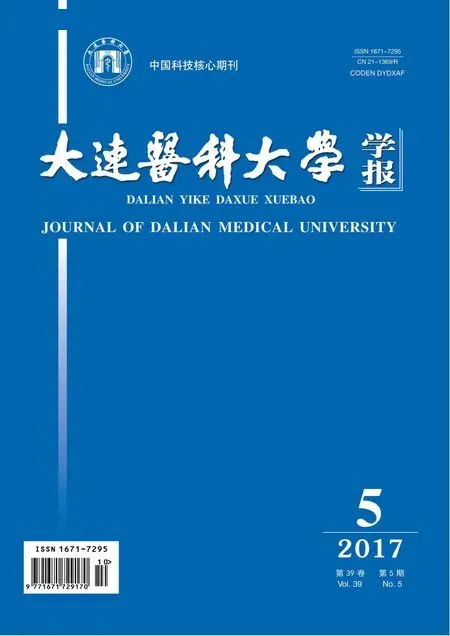2型糖尿病患者的早期胰岛素强化治疗
王子木,陈晓彤,陈慧梅
(南京大学医学院,江苏 南京 210093)
王子木(1995-),女,八年制本科生。E-mail:symmal@126.com
陈慧梅,教授。E-mail:chenhuimei@nju.edu.cn
综述
10.11724/jdmu.2017.05.20
2型糖尿病患者的早期胰岛素强化治疗
王子木,陈晓彤,陈慧梅
(南京大学医学院,江苏 南京 210093)
2型糖尿病是以逐渐损伤的胰岛B细胞功能和胰岛素抵抗为主要特征的代谢疾病。早期胰岛素强化治疗作为一种治疗2型糖尿病人的新型疗法,能严格控制病人血糖,有效改善胰岛B细胞功能和胰岛素抵抗,使得患者在一定时间内仅靠饮食运动就可以保持正常血糖,但也存在着低血糖和体重增加等副作用。本文就早期胰岛素强化治疗的概念、方案、作用以及可能存在的问题进行综述。
2型糖尿病;早期胰岛素强化治疗;胰岛B细胞;胰岛素抵抗
2型糖尿病(type 2 diabetes mellitus,T2DM)在我国的发病率日益升高。胰岛素是控制血糖、治疗T2DM的有力武器,但在传统疗法中,只有当口服降糖药实在无法达到控制目标时才启用胰岛素治疗。从20世纪末开始,不断有研究表明,对于新诊断的T2DM患者进行短期胰岛素强化治疗,可以有效改善胰岛B细胞功能,使患者在一定时间内仅靠饮食运动就可以保持正常血糖。现对这种疗法的内容、作用和常见问题作一综述。
1 早期胰岛素强化治疗的概念
T2DM的传统治疗采用阶梯式疗法,即从饮食运动到单药口服,再到联合口服,在联合口服也不能有效控制病情的情况下才会启用胰岛素治疗。而早期胰岛素强化治疗是针对符合条件的新诊断T2DM患者即进行短期的胰岛素强化治疗,使其血糖达到正常或者接近正常水平的治疗方法。
1993年,针对1型糖尿病(type 1 diabetes mellitus,T1DM)的“糖尿病控制与并发症试验”(diabetes control and complications trial,DCCT)最早提出了“胰岛素强化治疗”的概念,指使用胰岛素对患者血糖进行严格控制,使其达到正常或者接近正常的水平[1-2]。1997年,基于高血糖对胰岛B细胞功能损害早期可逆的理论,Ilkova等[3]借鉴了T1DM的这种疗法,针对新诊断的T2DM患者进行短期的胰岛素强化治疗,证实较短时间的血糖严控确实可以逆转B细胞的分泌缺陷,同时12例病人中有9例成功诱导出“蜜月期”,即在一段时间内不使用任何降糖药,仅靠饮食运动就能维持正常血糖,时间最长可达59个月。这种在糖尿病的初诊阶段就使用胰岛素进行短期严格血糖控制的疗法就是“早期胰岛素强化治疗”。随后,国内外开展了一系列研究,纷纷证明了早期胰岛素强化治疗对于T2DM患者的作用[4-11]。2013年《中国2型糖尿病防治指南》已明确将这种疗法写入其中,2016年美国糖尿病学会(American Diabetes Association,ADA)发布的指南中也提到“在新诊断的 2 型糖尿病患者,如有明显高血糖症状和/或血糖或 A1C 水平明显升高,考虑开始胰岛素治疗(单用或联合其他药物)”。目前早期胰岛素强化治疗已经是临床上常用的T2DM治疗方法。
2 早期胰岛素强化治疗的方案
由于《中国2型糖尿病防治指南(2013版)》和《2013短期胰岛素强化治疗专家共识》已经对治疗方案作了详细的规范,故在此仅简要叙述。
早期胰岛素强化治疗一般用于HbAlc>9%或空腹血糖>11.1 mmol/L的新诊断2型糖尿病患者,因为这部分病人口服药很难控制血糖达标,需要胰岛素来进行有效控制[12];控制目标为空腹血糖3.9~7.2 mmol/L(70~130 mg/dL),非空腹血糖≤10.0 mmol/L(180 mg/dL),可根据个体情况适当加强或放宽目标;持续时间在2周~3个月不等;在方案的选择上,每日多次胰岛素注射(multiple daily injection,MDI)、持续皮下胰岛素注射(continuous subcutaneous insulin infusion,CSII)、预混胰岛素每天注射2~3次都可以根据实际情况进行选择,不作特殊推荐,但相对MDI而言,CSII更接近人体生理的胰岛素分泌情况,血糖波动小、低血糖事件少,并可能在血糖控制达标率、平均达标时间、1年后缓解率上更有优势[11, 13];必要时可以联合胰岛素增敏剂等口服药物一起使用,以达到减少胰岛素用量、增强疗效等目的。
3 早期胰岛素强化治疗的作用
B细胞功能障碍和胰岛素抵抗是2型糖尿病的两个重要机制。2型糖尿病病人糖脂代谢异常,处于慢性高血糖、高游离脂肪酸状态,而长期高糖高脂会损伤胰岛B细胞,诱发胰岛素抵抗,即产生“糖毒性”和“脂毒性”。早期胰岛素强化治疗可在患病早期缓解糖脂毒性,从而较大程度地逆转胰岛B细胞损伤,减轻胰岛素抵抗,对于部分患者还可能诱导“蜜月期”产生,使患者在一定时间内不使用药物治疗,仅靠饮食运动就将血糖维持在正常水平[14]。
3.1 T2DM中的糖毒性和脂毒性
高血糖和高游离脂肪酸导致B细胞损伤的机制目前尚未被完全阐明,通常认为可能通过内质网应激、大量活性氧生成、促炎因子大量释放等途径干扰B细胞基因表达,损伤胰岛素分泌,诱导B细胞凋亡。近年来有学者提出了胰岛B细胞去分化的新学说,指在各种代谢刺激(如高血糖和高游离脂肪酸)下,B细胞内胰岛素内容物丢失,特征性基因表达丢失,B细胞去分化甚至转化为非B胰岛细胞,从而表现为胰岛B细胞损伤和数量减少[15]。
高血糖和高游离脂肪酸在胰岛素抵抗的产生过程中也扮演了重要角色。高血糖可以导致胰岛素介导的葡萄糖摄取产生障碍[16],还可以使得胰岛素在骨骼肌细胞间分布异常[17]。高游离脂肪酸则可能通过抑制葡萄糖氧化、促进肝脏糖异生和脂质异位沉积等诱发胰岛素抵抗[18]。
3.2 早期胰岛素强化治疗的特点
(1)早期胰岛素强化治疗提倡“早期”治疗,即对于符合条件的新诊断患者一开始就采用胰岛素治疗。“早期”的目的在于尽早纠正高血糖,减少糖毒性对胰岛B细胞的损害,从而促进其功能达到最大程度的恢复,同时诱导“蜜月期”的出现。Stein CM等[19]发现病程较短、血糖较低的病人更容易从胰岛素强化治疗中获益,Xu Wen等[20]的研究也表明从有糖尿病症状到确诊的时间越短从早期胰岛素强化治疗获益更大。
(2)提倡“强化”治疗,即较常规治疗更加严格地控制血糖,使其尽可能接近正常值。研究表明,只有进行强化治疗,使血糖水平“正常化”,才可能诱导“蜜月期”的出现,仅使血糖水平有一定幅度的下降不能达到这一效果[21]。Wang Z等[22]的B细胞去分化与再分化的试验中,在使用胰岛素治疗后,小鼠B细胞内胰岛素内容物恢复,并且重新产生了对磺脲类药物的反应;同时他们也发现,血糖控制得越接近正常,胰岛素内容物恢复得越接近正常。
(3)提倡使用外源性胰岛素治疗。Weng J等[11]和Chen HS等[5]的研究表明在早期强化治疗中,与口服降糖药相比,胰岛素能够更好地改善B细胞功能,诱导出时间更长的“蜜月期”。可能原因是相对于口服药而言,胰岛素能更好地控制血糖并且让B细胞“休息”。
4 早期胰岛素强化治疗可能存在的问题
4.1 低血糖
低血糖与心血管事件风险和全因死亡率的上升相关[23],是医生和患者使用胰岛素强化治疗最主要的担忧。虽然相关临床试验表示早期胰岛素强化治疗很少发生严重低血糖事件[5, 8, 11],但是一旦发生就可能导致严重后果,尤其是心血管疾病高危的T2DM患者[12]。可以通过仔细评估治疗对象情况,如老年人就不宜使用;选择合适的治疗方式、使用胰岛素类似物;制定个体化血糖控制方案;加强健康教育和血糖监测等方法来降低低血糖发生风险。
4.2 体重增加
体重增加是长期胰岛素治疗的常见副作用,但是早期胰岛素强化治疗由于时间较短,一般认为对体重影响较小[4-5,7,10-12]。二甲双胍引起体重增加的风险相对较低,有体重增加风险时,可以采取胰岛素联用二甲双胍的形式[24]。
5 结 语
20世纪90年代以来,早期胰岛素强化治疗改善B细胞功能、诱导长期缓解的作用已经得到证实,这一疗法也在临床广泛使用。但是,我们应当看到,在新诊断的T2DM患者中只有一半左右可以获得长期缓解,并且随着时间延长缓解率不断下降。怎样更好地预测哪些病人可以达到临床缓解、怎样提高缓解率将有待进一步的研究。值得一提的是,对于T2DM患者光有血糖控制是不够的,血糖、血压、血脂多方位综合干预可能会带来更多益处[25-26]。
[1] Murphy LO. DCCT Research Group.The effect of intensive treatment of diabetes on the development and progression of long-term complications in insulin-dependent diabetes mellitus. The Diabetes Control and Complications Trial Research Group[J]. N Engl J Med, 1993,329(14): 977-986.
[2] 宋晓晓,周智广. 1型糖尿病强化治疗的利弊[J]. 中国医学前沿杂志(电子版), 2012,4(3): 8-10.
[3] Ilkova H, Glaser B, Tun kale A, et al. Induction of long-term glycemic control in newly diagnosed type 2 diabetic patients by transient intensive insulin treatment[J]. Diabetes Care, 1997, 20(9): 1353-1356.
[4] Chen A, Huang Z, Wan X, et al. Attitudes toward diabetes affect maintenance of drug-free remission in patients with newly diagnosed type 2 diabetes after short-term continuous subcutaneous insulin infusion treatment[J]. Diabetes Care, 2012, 35(3): 474-481.
[5] Chen HS, Wu TE, Jap TS, et al. Beneficial effects of insulin on glycemic control and beta-cell function in newly diagnosed type 2 diabetes with severe hyperglycemia after short-term intensive insulin therapy[J].Diabetes Care, 2008, 31(10): 1927-1932.
[6] Chon S, Oh S, Kim SW, et al. The effect of early insulin therapy on pancreatic β-cell function and long-term glycemic control in newly diagnosed type 2 diabetic patients[J]. Korean J Intern Med, 2010, 25(3):273-281.
[7] Hu Y, Li L, Xu Y, et al. Short-term intensive therapy in newly diagnosed type 2 diabetes partially restores both insulin sensitivity and β-cell function in subjects with long-term remission[J]. Diabetes Care, 2011, 34(8): 1848-1853.
[8] Huang Z, Wan X, Liu J, et al. Short-term continuous subcutaneous insulin infusion combined with insulin sensitizers rosiglitazone, metformin, or antioxidant α-lipoic acid in patients with newly diagnosed type 2 diabetes mellitus[J]. Diabetes Technol Ther, 2013, 15(10): 859-869.
[9] Mu PW, Chen YM, Lu HY, et al. Effects of a combination of oral anti-diabetes drugs with basal insulin therapy on β-cell function and glycaemic control in patients with newly diagnosed type 2 diabetes[J].Diabetes Metab Res Rev, 2012, 28(3): 236-240.
[10] Ryan EA, Imes S, Wallace C. Short-term intensive insulin therapy in newly diagnosed type 2 diabetes[J]. Diabetes Care, 2004, 27(5): 1028-1032.
[11] Weng J, Li Y, Xu W, et al. Effect of intensive insulin therapy on beta-cell function and glycaemic control in patients with newly diagnosed type 2 diabetes: a multicentre randomised parallel-group trial[J].Lancet, 2008, 371(9626): 1753-1760.
[12] 翁建平. 2型糖尿病胰岛素治疗的时机[J]. 中华内分泌代谢杂志, 2008, 24(2): 123-125.
[13] Li FF, Fu LY, Zhang WL, et al. Blood Glucose Fluctuations in Type 2 Diabetes Patients Treated with Multiple Daily Injections[J]. J Diabetes Res, 2016, 2016: 1028945.
[14] Kramer CK, Zinman B, Retnakaran R. Short-term intensive insulin therapy in type 2 diabetes mellitus: a systematic review and meta-analysis[J]. Lancet Diabetes Endocrinol, 2013, 1(1): 28-34.
[15] Talchai C, Xuan S, Lin H, et al. Pancreatic β Cell Dedifferentiation as a Mechanism of Diabetic β CellFailure[J]. Cell, 2012, 150(6): 1223-1234.
[16] Ciaraldi TP, Abrams L, Nikoulina S, et al. Glucose transport in cultured human skeletal muscle cells. Regulation by insulin and glucose in nondiabetic and non-insulin-dependent diabetes mellitus subjects[J].J Clin Invest, 1995, 96(6): 2820-2827.
[17] Kolka CM, Castro AV, Kirkman EL, et al. Modest hyperglycemia prevents interstitial dispersion of insulin in skeletal muscle[J]. Metab Clin Exp, 2015, 64(2): 330-337.
[18] Samuel VT, Shulman GI. The pathogenesis of insulin resistance: integrating signaling pathways and substrate flux[J]. J Clin Invest, 2016, 126(1): 12-22.
[19] Stein CM, Kramer CK, Zinman B, et al. Clinical predictors and time course of the improvement in β-cell function with short-term intensive insulin therapy in patients with Type 2 diabetes[J].Diabet Med, 2015, 32(5): 645-652.
[20] Xu W, Li Y B, Deng WP, et al. Remission of hyperglycemia following intensive insulin therapy in newly diagnosed type 2 diabetic patients: a long-term follow-up study[J]. Chin Med J (Engl), 2009, 122(21):2554-2559.
[21] 李光伟. 新诊断2型糖尿病及其‘蜜月期’[J].实用糖尿病杂志, 2007,3(4): 3-4.
[22] Wang Z, York NW, Nichols CG, et al. Pancreatic β cell dedifferentiation in diabetes and redifferentiation following insulin therapy[J].Cell Metab, 2014, 19(5): 872-882.
[23] Minimizing Hypoglycemia in Diabetes[J].Diabetes Care, 2015, 38(8):1583-1591.
[24] 郭立新.2型糖尿病传统降糖治疗的问题与挑战[J].药品评价, 2014,11(15): 27-31.
[25] Schroeder SA. Multifactorial intervention and mortality in type 2 diabetes[J]. N Engl J Med, 2008,358(21):2292.
[26] Bassan MM. Multifactorial intervention and cardiovascular disease in type 2 diabetes[J].N Engl J Med, 2003,348(19):1925-1927.
Earlyintensiveinsulintherapyinpatientswithtype2diabetes
WANG Zimu, CHEN Xiaotong, CHEN Huimei
(NanjingUniversitySchoolofMedicine,Nanjing210093,China)
Type 2 diabetes is a metabolic disease characterized by the progressive deterioration of islet B cell function and insulin resistance. Early intensive insulin therapy, as a novel strategy of type 2 diabetes, can improve islet B cell function and insulin resistance by achieving restrictive glycemic control using insulin. This therapy enables patients to maintain normal blood glucose level after the therapy merely on lifestyle interventions and diet control. However, early intensive insulin therapy may cause some side effects, including increased risk of hypoglycemia and weight gain. This article reviews the definition, the therapeutic schemes, the effects and possible problems of early intensive insulin therapy. We hope that we can help physicians and medical students learn more about this therapy.
type 2 diabetes; early intensive insulin therapy; islet B cell; vascular complication
R587.1
A
1671-7295(2017)05-0503-04
王子木,陈晓彤,陈慧梅.2型糖尿病患者的早期胰岛素强化治疗[J].大连医科大学学报,2017,39(5):503-506.
2017-04-10;
2017-06-25)

